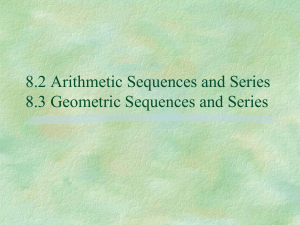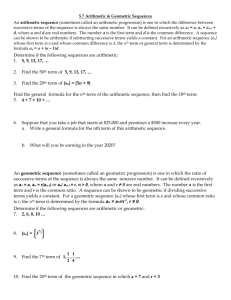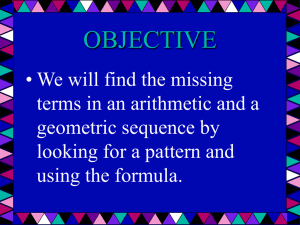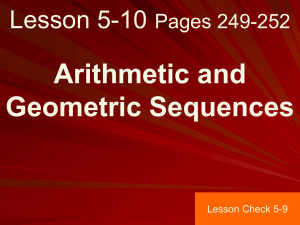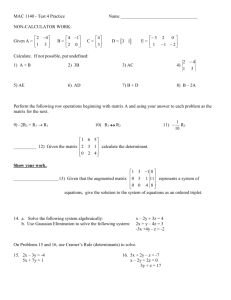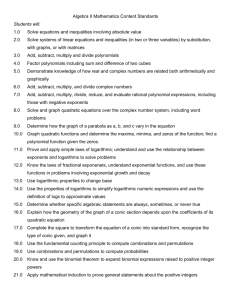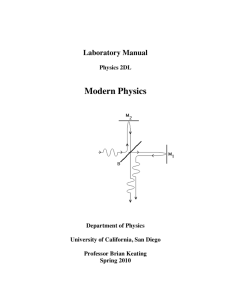Formal Definition of an arithmetic sequence
advertisement
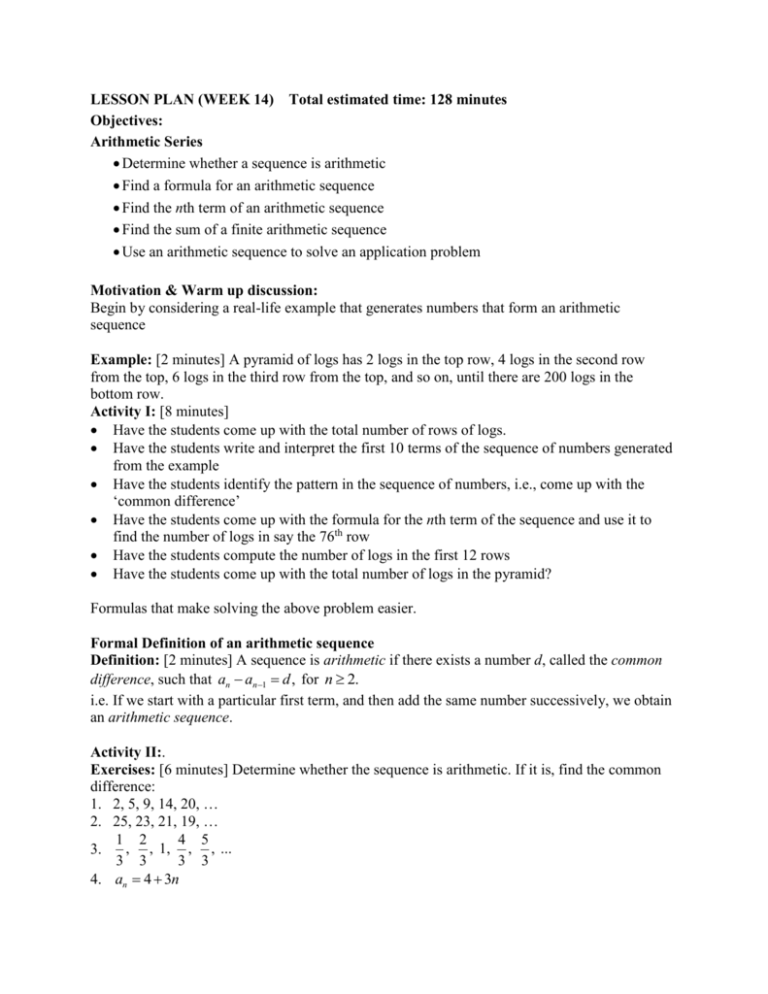
LESSON PLAN (WEEK 14) Total estimated time: 128 minutes Objectives: Arithmetic Series Determine whether a sequence is arithmetic Find a formula for an arithmetic sequence Find the nth term of an arithmetic sequence Find the sum of a finite arithmetic sequence Use an arithmetic sequence to solve an application problem Motivation & Warm up discussion: Begin by considering a real-life example that generates numbers that form an arithmetic sequence Example: [2 minutes] A pyramid of logs has 2 logs in the top row, 4 logs in the second row from the top, 6 logs in the third row from the top, and so on, until there are 200 logs in the bottom row. Activity I: [8 minutes] Have the students come up with the total number of rows of logs. Have the students write and interpret the first 10 terms of the sequence of numbers generated from the example Have the students identify the pattern in the sequence of numbers, i.e., come up with the ‘common difference’ Have the students come up with the formula for the nth term of the sequence and use it to find the number of logs in say the 76th row Have the students compute the number of logs in the first 12 rows Have the students come up with the total number of logs in the pyramid? Formulas that make solving the above problem easier. Formal Definition of an arithmetic sequence Definition: [2 minutes] A sequence is arithmetic if there exists a number d, called the common difference, such that an an 1 d , for n 2. i.e. If we start with a particular first term, and then add the same number successively, we obtain an arithmetic sequence. Activity II:. Exercises: [6 minutes] Determine whether the sequence is arithmetic. If it is, find the common difference: 1. 2, 5, 9, 14, 20, … 2. 25, 23, 21, 19, … 1 2 4 5 , , 1, , , ... 3. 3 3 3 3 4. an 4 3n Finding a formula for the nth term of any arithmetic sequence: Teacher Activity: [4 minutes] Denote the common difference by d, and write the first four terms: a1 , a2 a1 d , a3 a2 d (a1 d ) d a1 2d a4 a3 d (a2 d ) d a1 3d Activity III: [4 minutes] Have the students state the relation between the coefficient of d and the number of the term, n in each case. Have the students generalize a formula for the nth term of the arithmetic sequence, i.e. come up with the following result: Result 1: The nth term of an arithmetic sequence is given by an a1 (n 1)d , for any n 1 Activity IV: [4 minutes] Have the students use the formula to find the nth term of the arithmetic sequences identified in Activity II (pay more attention to exercise # 4) Finding a formula for the sum of the first n terms of any arithmetic sequence through an example (Finite Arithmetic Series): Teacher Activity [8 minutes] Consider the sequence of the first 20 even numbers, 2, 4, 6, 8, …,38, 40 (Confirm that the students know why the sequence is arithmetic) The sum of the first 20 terms is denoted by S 20 . Then S 20 = 2 + 4 + 6 + 8 + …+ 38 + 40 If we reverse the order of the sum, then S 20 = 40 + 38 + … + 8 + 6 + 4 + 2 If we add the corresponding terms of each side of the above equations, we get 2 S 20 = (2 + 40) + (4 + 38) + (6 + 36) +… + (38 + 2) + (40 + 2) = 20(42) 20 S 20 = (2 + 40) 2 Activity V: [5 minutes] Have the students write a formula for the sum of the first 20 terms of the above arithmetic sequence, i.e. come up with the following result: (number of terms in the sequence) ( first term + last term) 2 Have the students generalize a formula for the sum of the first n terms of an arithmetic sequence, i.e. come up with the following result: S 20 = Result 2: The sum of the first n terms of an arithmetic sequence is given by n Sn (a1 an ) 2 n Alternative: Sn [2a1 (n 1)d ]. ( WHY?) 2 Activity VI: [8 minutes] 1. Have the students use the formula to find the sum of the first 15 terms of the arithmetic sequences identified in Activity II 300 2. Find the sum (2n 5) n 1 Activity VII: (Applications) Exercises [8 minutes] 1. Have the students apply the formulas above to the example in Activity I 2. You take a job starting with an hourly rate of $16. You are given a raise of 25 cents per hour every 2 months for 5 years. What will your hourly wage be at the end of 5 years? 3. A student saves $3 dollars on August 1, $5 on August 2, $7 on August 3, and so on. How much will she save in August? Objectives Geometric Series Determine whether a sequence is geometric Find a formula for a geometric sequence Find the nth term of a geometric sequence Find the sum of a finite geometric sequence Use a geometric sequence to solve an application problem Motivation & Warm up discussion: Begin by considering a real-life example which generates numbers that form a geometric sequence Example [2 minutes] One morning (day 1), three people start a chain letter via e-mail. Each of them sends a message to five other people with the instructions that the receiver must forward the message to 5 other people the following morning. Assume this process continues each morning without any repetition of recipients. Activity I: [8 minutes] Have the students calculate the number of new recipients to the message on day 2, day 3, day 4 and day 5. Have the students identify the pattern in the sequence of numbers generated in the first activity – i.e. come up with the ‘common ratio’ Have the students come up with the formula for the nth term of the sequence and use it to calculate the number of new recipients on the 7th day Have the students calculate the total number of people who have received the message in the first 5 days Formulas that make solving the above problem easier Formal Definition of an geometric sequence [2 minutes] Definition: A sequence is geometric if there exists a number r. called the common ratio, such that an 1 r , or an 1 an r , for any n 1. an i.e. If we start with a particular first term, and then multiply the same number successively, we obtain a geometric sequence Activity II: [4 minutes] Exercises: Determine whether the sequence is geometric. If it is, find the common ratio: 1. 3, 6, 10, 15, … 2. 1, -2, 4, -8, … 1 1 1 3. 1, , , , ... 2 4 8 2 4. an 2 3 n 1 Finding a formula for the nth term of any geometric sequence: Teacher Activity [4 minutes] Denote the common ratio by r, and write the first few terms: a1 , a2 a1r , a3 a2 r (a1r )r a1r 2 a4 a3r (a1r 2 )r a1r 3 Activity III: [4 minutes] Have the students state the relation between the power of r and the number of the term, n in each case. Have the students generalize a formula for the nth term of the geometric sequence, i.e. come up with the following result: Result 3: The n-th term of a geometric sequence is given by an a1r n 1 , for any n 1. Activity IV: [4 minutes] Have the students use the formula to find the nth term of the geometric sequences identified in Activity II Formula for the sum of the first n terms of any geometric sequence (Finite Geometric Series): Teacher Activity [3 minutes] Write the following result and explain the symbols Result 4: The sum of the first n terms of a geometric sequence is given by a (r n 1) Sn 1 , for any r 1. r 1 Activity V: [10 minutes] 1. Have the students use the formula to find the sum of the first 15 terms of the geometric sequences identified in Activity II 2 8 n 1 5 30 2. Find the sum n 1 Activity VI: (Applications) Exercises [10 minutes] 1. Have the students apply the formulas above to the example in Activity I 2. A deposit of $200 is made on the first day of each month in a savings account that pays 8% compounded monthly. What is the balance in the account at the end of 2 years? Activity VII: [4 minutes] 1 and n 1, 2, 5, 10, 50, and 100. 2 2. Have the students make a conjecture about the value of r n as n if | r | 1 3. Have the students find a formula for the sum of an infinite geometric 1. Have the students use a calculator to evaluate r n for r Teacher Activity [2 minutes] Write the following result and explain the symbols Result 5: When | r | 1 , the sum of the infinite geometric series a1 a2 r a3r 2 ... is given by a S 1 . r 1 When | r | 1 , an infinite geometric series does not have a sum. Activity VIII: [14 minutes] 1 1. Find the sum 4 n 1 2 n 1 2 2. Find the sum 3 n 0 3 3. Draw four squares adjacent to each other. The first with side length of 1 unit, the second with side length of ½, the third with side length ¼, and the fourth with side length 1/8. Calculate the area of each square. Does this form a geometric sequence? Calculate the total area of the four squares using the appropriate formula given above. If the process of adding squares with half the perimeter of the previous square continued indefinitely, what would the total area of all the squares be? n


